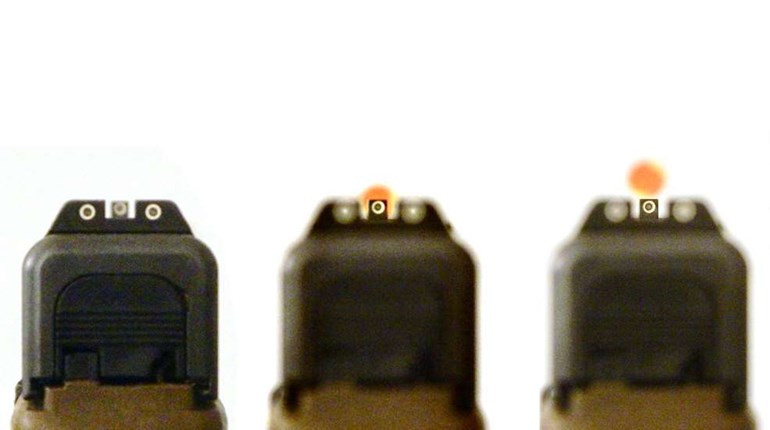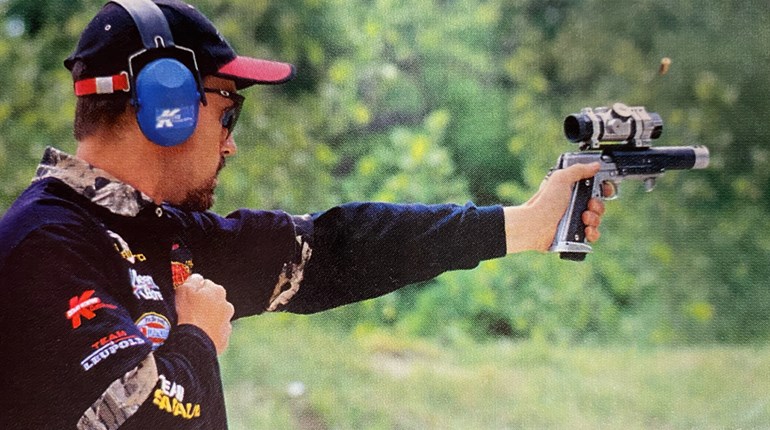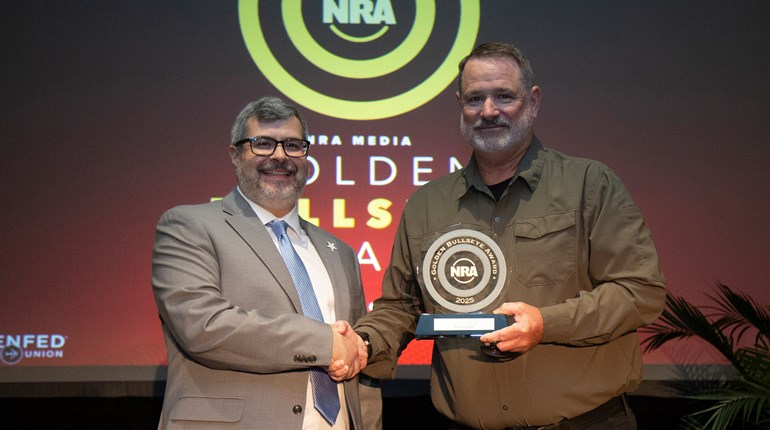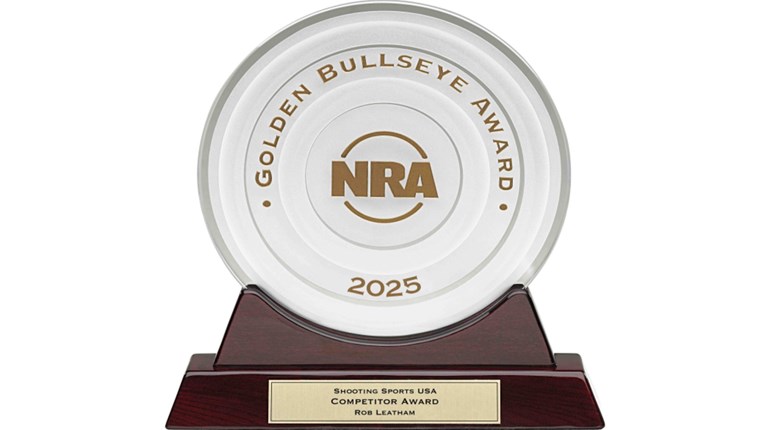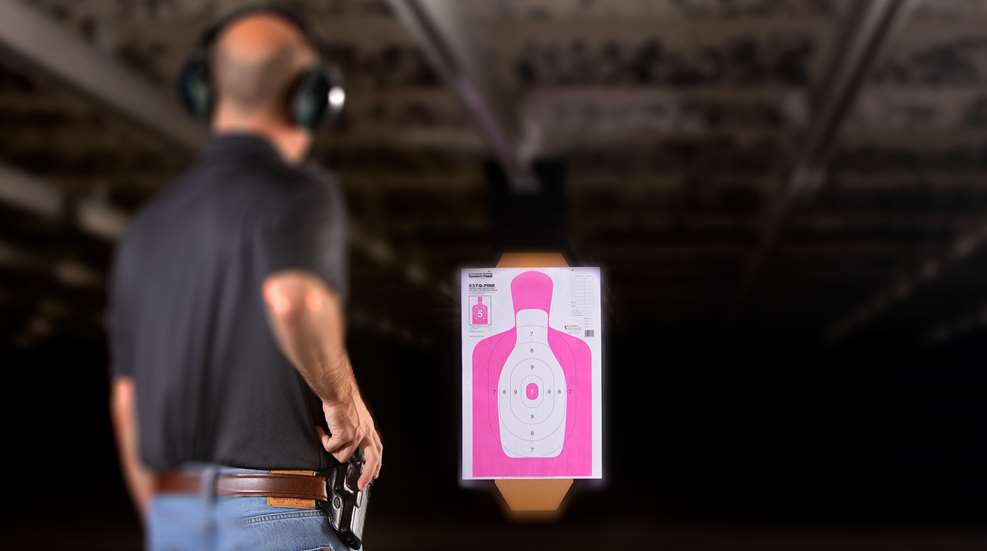
Shooting at the very edge of your skills envelope requires tremendous mental focus and well-developed shooting awareness. However, some shooters believe that shooting awareness and mental focus are one in the same. They are not. Using pistol shooting (combat or competition) as an example, what is the difference between the two and how can it help you hone your shooting skills to a razor’s edge?
Shooting Awareness
The shooting process, as per multi-world champion and Master Instructor Rob Leatham, is defined as “bringing stability to alignment and breaking the shot without disturbing the muzzle’s orientation with the target.” Shooting awareness is a training-industry term applied to the act of carefully observing what’s going on around you throughout the entire shooting process from start to finish.
Leatham further elaborates on the shooting process: “Hold the gun tightly. As tight as possible. Those who hold on tighter will do better. Pull the trigger fast. Instantaneously if possible. If not possible, those who can [pull the trigger fast] will do better. Get the gun in alignment fast [with your intended target]. Those who get it into alignment faster will do better. Hold that alignment throughout the shot. Do not and you will fail. Return the gun from recoil instantaneously. Those who can will do better …”
The shooting process is comprised of a series of sub-processes enabling the shooter to perform well. Shooting awareness, as applied to the shooting process, can be partitioned into three categories: visual, mental and tactile.

Visual Awareness
Visual awareness provides brainbox input from observing as many elements as possible in your immediate field of fire. Such input should include, but is not limited to, target identification, muzzle movement, slide reciprocation, sights/dot movement and the like, before, during and after breaking each shot.
A typical use of visual awareness is when you increase sight clarity commensurate with the difficulty of the shot. Visual awareness can be used to decrease sight clarity on less technical shots at faster speeds. Expert shooter Brian Enos discusses this in detail in his dissertation on “Five Aimings.” You can easily and needlessly spend valuable tenths of a second on increased sight clarity where it is not needed. Conversely, visual awareness is used to increase visual clarity on those more technical shots.
Visual awareness is an indispensable tool used in shooting diagnostics. You can’t fix something you can’t see. Observe such details as what direction and how high did your sighting system rise. Was there any lateral muzzle movement? If so, was that lateral movement severe enough to cause a stair-stepping round-placement affect pushing the muzzle in either direction (other than 6 to 12 o’clock)? Visual awareness is additionally critical to performance observation throughout any dry-fire exercise or drill where there’s no explosion at the end of your arm to otherwise distract you.
Mental Awareness
Mental awareness, as recommended by professional firearm instructors to entry-level shooters, is utilized to take an inventory of the sub-processes of the shooting process itself such as grip, alignment, trigger control, etc., either mentally or verbally.
Mentally or even verbally pronouncing each inventory item helps remind the entry-level shooter of shooting-process fundamentals and their required order of execution. For example, when presenting the handgun from your holster, your inventory list might be: “Strong hand grip?” Check. “Begin the muzzle alignment process with hands coming together firmly creating more surface contact with the pistol and therefore greater control of the muzzle?” Check. “Complete the alignment process?” Check. “Have the eyes verified alignment?” Check. And last, “Press off the round.” Check (although this check will be somewhat louder than the rest).
Tactile Awareness
The next level up from this methodology of thinking it through is feeling it through. Now that the shooter has gained the ability to recognize the difference between “right” (correct; it worked) and “wrong” (incorrect; it didn’t work) processing to include proper timing of the appropriate sequence of events, they can progress in skill by feeling it (tactile), as opposed to thinking about it. Did your initial grip feel right during the presentation? Do you recall feeling even the slightest change in grip pressure at any time during the shooting process? Did you feel a trigger press error or was it a thing of absolute beauty (sheer technical perfection) or something in between?
Once past running a “feeling inventory,” the shooter may experience “doing it right” (it worked) more often than “doing it wrong” (it didn’t work) from their perspective. At the time when the shooter experiences “can’t do it wrong,” the shooting process has at long last moved from the conscious to the subconscious. Here the shooter has achieved consistency with unconscious competence.
Applying your shooting awareness can be a lengthy road toward shooting competence to say the least, but some shooters progress exponentially quicker than others. Instructors attribute this to certain natural (you’re born with it) physiological and psychological attributes or characteristics inherent in “natural” (so to speak) shooters. It just comes to them faster than those of us normal earth walkers who have no other choice but to work our bunny tails off trying to get there.

Mental Focus
Mental focus is what defines shooting discipline. It ranges from personal perception developed from prior experience, to pushing the very limits of your operational capacity. Like shooting awareness, it is applied to the shooting process and can be similarly partitioned into three categories: physical movement (mechanical), approach (mental perspective) and sustainment (non-physical or mental endurance).
Physical
Mental focus as applied to the physical movement of shooting mechanics is to push the process well beyond your comfort level.
We all want to, of course, hit what we’re aiming at. However, to get better at the shooting process is to train yourself to continually push outside your comfort zone, bend that proverbial skills envelope and by doing so move your personal-skills development up a notch or two. Fighting to reach beyond your physical comfort level can be as uncomfortable as a burning, itching hemorrhoid. To ease such discomfort, Leatham advises his students to simply “get comfortable being uncomfortable.”
The adage “A master has failed more than the novice has tried” applies here directly. The more you push the process by staying mentally focused on your body mechanics, the greater your control in pushing to the edge of your skillset. For example, if you’re trying to bring your overall time down a tenth of a second on your presentation times and you keep pushing the process (executing the drill faster and faster), at some point in your training the wheels will fall off, and when they do, that’s a good thing, because it tells you where to next focus your efforts.
A shooter can only learn by making mistakes, observing what happened, understanding exactly why it happened and then, following appropriate remediation, put on a new wheel and shoot it again. The discipline here is to stay within the shooting process mentally as opposed to “trying to go fast”–where you are trying and not shooting. It is a tremendous benefit to not only accept, but also embrace failure as an integral aspect of your training regimen.

Approach
In terms of mental approach, “layered complexity” applies to the demands of any shooter trying to complete more than one task. For example, instead of one round from the holster on T1, the requirement is now two rounds from the holster on T1, run to cover and then place two rounds on T2, change your shooting position and then one round to the head of T3.
A less complex example of a mental approach to a shooting array (or tactical problem) is attempting to clear a plate rack without missing, aka shooting it clean. If the shooter approaches it mentally as “shoot all six plates” that is processed very different internally than the shooter who mentally approaches it as “six individual shots—one at a time, six times.” The proof is in the subsequent performance.
The “one-task-at-a-time” mental approach also plays a critical role in defensive tactics such as close-quarter battle and room-clearing techniques. Trying to complete more than one task at the same time, especially at high-performance speeds, is like having one foot in two separate canoes on a river. Complete one task fully from start to finish before starting the next. When cutting the pie on a room-clearing drill for example, start your movement and angle to your next unknown area. Once that piece of the pie is cleared, then move on to the next one.
In one study referencing task performance, a specialty-team leader who ran the numbers on his team performance over the years found that the decrease in performance from single task to multi-task (layered complexity) is a 20 percent variance in performance for the average shooter. For upper-class specialty teams (Tier 1 government assets for example) that number is closer to 10 percent, but either way there is a variance where shooting performance is attenuated by complexity based solely on mental approach to task performance.
The bottom-line mental-approach solution to layered complexity is to solve one shooting problem at a time and to stockpile good repetitions in your training. The more familiar the (combative or competition) shooter becomes, gaining experience and confidence, with the mental approach of solving one problem at a time regardless of the number of problems, the better his performance and especially under duress.

Sustainment
Last, but certainly not least is mental sustainment. Your highest-performance-level shooting is achieved by maximum mechanical efficiency with no unnecessary movement throughout the entire process for the number of times a shot is demanded of the shooter. In a defensive scenario, it may be for half a magazine. In a competition, it may be for something along the lines of 26 or more rounds fired in a single stage.
To maintain control of the firearm is one thing, but to maintain the mental discipline it takes to control what goes on between your earmuffs is a completely different matter altogether. You can use your body and shooting awareness to monitor and control your physical movement, but the one and only tool available to help you keep control of what’s going on internally is the sheer discipline to not let up on that mental gas pedal until the last and final round is fired.
Mental focus is a rarely tread path for the beginning and even intermediate level shooter as awareness (justifiably) is placed on body mechanics, such as proper grip, alignment, hold, press, etc. At the higher levels of shooting performance, fighting for hundredths of a second allows no room for thought, feelings or even comfort. For some shooters, it takes everything they’ve got mentally to hold a completely “empty mind.” Other, usually more seasoned shooters, can still the monkey mind by achieving and maintaining an unwavering, Zen-like state of “no thought” throughout the entire string of fire, from start to finish. Much easier said than done.
When training to meet any shooting standard where you have come up against your maximum physical ability—that is, where you mechanically cannot move any faster (aka operational limit)—there’s no possibility of further mechanical improvement. It’s where you are maxed out physically. At that point, the only possible shooting performance improvement attainable is via increasing your shooting awareness and improving your mental focus by being mentally ready. Mental readiness is simply exploiting your mental focus and shooting awareness to get yourself set to shoot, mentally and visually, sooner.
Achieving maximum mechanical efficiency of the shooting process is less than 50 percent of the shooting solution. New York Yankees Hall of Fame catcher and manager, the late Yogi Berra’s iconic quote “Baseball is 90 percent mental. The other half is physical” also applies to the shooting process. You can only go so far with mechanical skill.
At the upper levels of competition or defensive/combative tactics, every shooter is trained up to be fast and accurate, but proficiency and performance consistency are accomplished by bringing mental readiness to bear with increased shooting awareness and mental focus.












